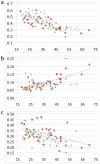Epigenetic predictor of age
- PMID: 21731603
- PMCID: PMC3120753
- DOI: 10.1371/journal.pone.0014821
Epigenetic predictor of age
Abstract
From the moment of conception, we begin to age. A decay of cellular structures, gene regulation, and DNA sequence ages cells and organisms. DNA methylation patterns change with increasing age and contribute to age related disease. Here we identify 88 sites in or near 80 genes for which the degree of cytosine methylation is significantly correlated with age in saliva of 34 male identical twin pairs between 21 and 55 years of age. Furthermore, we validated sites in the promoters of three genes and replicated our results in a general population sample of 31 males and 29 females between 18 and 70 years of age. The methylation of three sites--in the promoters of the EDARADD, TOM1L1, and NPTX2 genes--is linear with age over a range of five decades. Using just two cytosines from these loci, we built a regression model that explained 73% of the variance in age, and is able to predict the age of an individual with an average accuracy of 5.2 years. In forensic science, such a model could estimate the age of a person, based on a biological sample alone. Furthermore, a measurement of relevant sites in the genome could be a tool in routine medical screening to predict the risk of age-related diseases and to tailor interventions based on the epigenetic bio-age instead of the chronological age.
Conflict of interest statement
Figures



References
-
- Goyns MH. Genes, telomeres and mammalian ageing. Mech Ageing Dev. 2002;123:791–799. - PubMed
Publication types
MeSH terms
Substances
LinkOut - more resources
Full Text Sources
Other Literature Sources
Medical
Molecular Biology Databases
Miscellaneous

